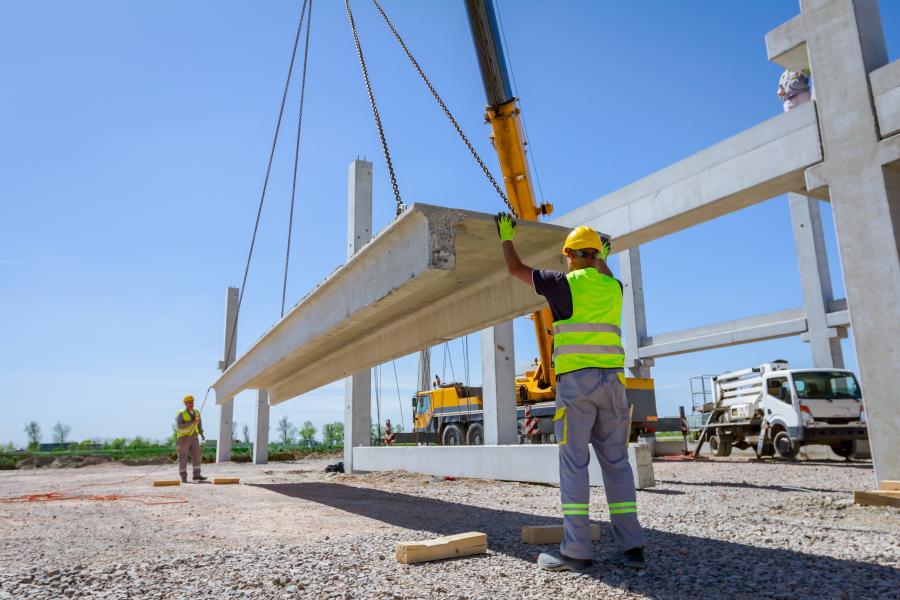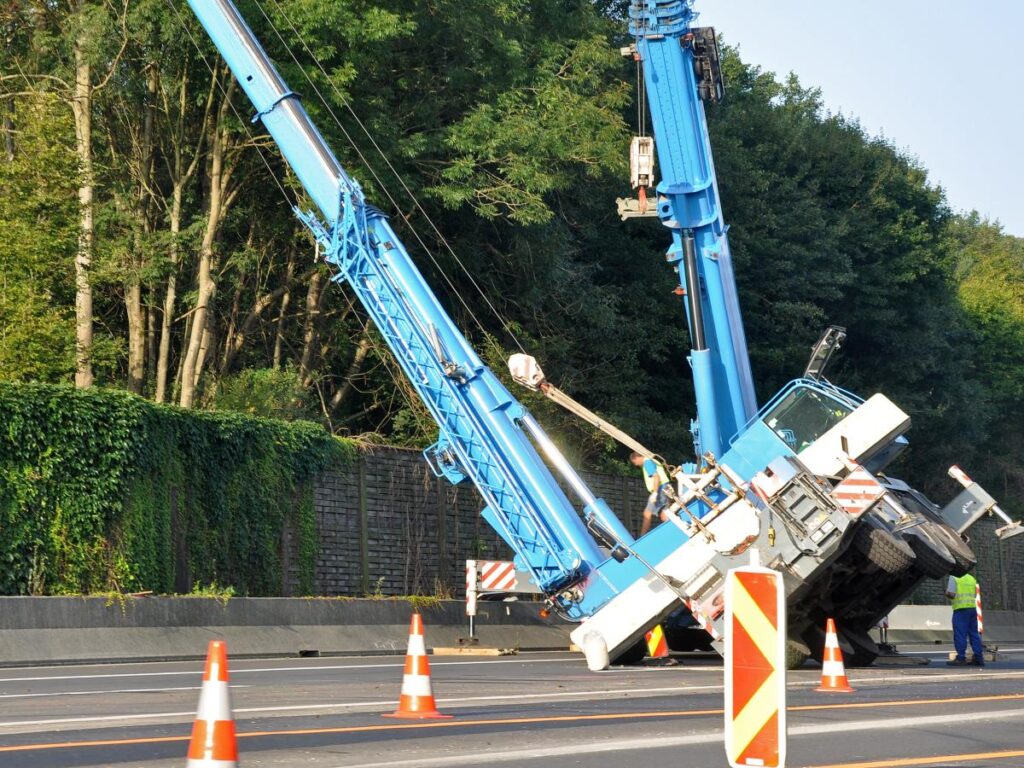Adobe Stock photo
OSHA cited falls, tip-overs, struck-bys, electrocutions, being caught between a crane and other structures and unqualified operators as the most common crane-related hazards.
The construction crane industry is shoring up safety efforts to prevent accidents like those that have brought negative visibility to the market sector in the past few years.
CCO and the NCCCO Foundation have formed an alliance with OSHA to keep the industry informed about OSHA’s safety initiatives. That bodes well for contractors and crew members working around the machines every day.
In November, the three organizations signed a formal agreement to collaborate in providing information, guidance and resources. The goal is to promote workplace safety and health and awareness of workers’ rights and employers’ responsibilities under OSHA.
“Workers … can face serious and potentially life-threatening hazards if they are not properly trained or protected,” said Doug Parker, OSHA assistant secretary. “Our alliance with these industry leaders focuses on training workers and working with employers to make safety and health a core value.”
Parker said this will be accomplished through the implementation of best industry practices to ensure workers’ safety.
“We look forward to making our industry safer,” Thom Sicklesteel, CCO chief executive, said at the signing in Washington, D.C.
Haste Makes Waste, Risk
In Aubrey, Texas, last year, OSHA found the death of a crew member could have been prevented if required mobile crane safety procedures had been followed.
According to DOL, OSHA investigators learned the 23-year-old and other workers were constructing a metal building when the crane collapsed. The agency determined the company exposed its employees to struck-by hazards by overloading the crane beyond its weight limitations.
OSHA cited the company for not using temporary alternative measures when the load and radius cell did not work. The agency also cited the employer for the operation of a mobile crane in excess of rated capacity and operation in a matter that exceeded rated capacity.
The company also was cited for failure to create and employ an accident prevention program; perform regular work site inspections; and meet federal standards for crane and wire rope inspections.
OSHA proposed a fine of nearly $263,000, saying the employer disregarded the safety of its crew, “willfully ignoring required safety standards.”
“And one worker suffered the deadly consequences of the company’s failures,” said Timothy Minor, OSHA area director.
In Arizona, a crane crew member suffered electrocution during the installation of an air conditioner. A state workplace safety inspection determined the employer violated multiple safety regulations in the accident.
Arizona Division of Occupational Safety and Health (ADOSH) said following safety and electrical precautions could have prevented the death. The inspection found the crane’s cable was too close to electrical lines without shutting off power, according to television station abc15 in Tucson.
“There was no documentation the 26-ton crane had been inspected annually as required,” said Anne Ryman, reporter. “In addition, the sling used to lift the 681-pound air conditioning unit was frayed and should not have been used,” the inspection said.

Adobe Stock photo
The crane company was fined more than $32,000, and one citation was classified as “willful serious.”
This designation is the most serious worker-safety violation, levied only where the inspector says employers knowingly failed to follow safety regulations.
Last summer, the crane and operator were hired to lift and set the air-conditioning unit into place. The crane operator lowered the unit with the cable coming within 2 ft. of electrical lines, according to the ADOSH report. The operator ordered the unit to be pushed where it was supposed to go on the roof. The cable hit the power lines, electrocuting the 23-year-old worker.
“The crane operator told us right up front that he knew he wasn’t supposed to be that close to the line,” said Mark Norton, ADOSH director.
The state then fined the crane company an additional $25,000 for the willful citation resulting in a worker death. The money goes to the worker’s family.
Crane operators in Atlanta say the fast pace of construction is raising risk levels when safety concerns on the job are ignored.
Ashli Lincoln with wsbtv.com in Atlanta reported that operators attribute the situation to pressure to build quickly and move on.
“When we get a job, we hit the ball running,” according to one crane operator who said the fast pace comes with a list of ignored safety concerns.
“I recently had to walk off a job because it was so unsafe,” one operator said.
Operators said they’ve been asked to operate in high wind conditions, carry excessively heavy loads, work 80-hour weeks, and rely on inexperienced riggers.
One crane operator recalled a project where none of the riggers spoke clear English, adding that that itself is a major safety concern.
Policy of Doing It Right
Fortunately, the incident-free construction jobs outweigh the sites that log accidents and incidents. The contractors who believe in best practices do it right.
Alamo Crane Service Inc. (ACS), selected to receive a subcontractors association safety award, is one of those contractors.
American Subcontractors Association (ASA) awarded Alamo a 2022 National Safety Award last spring. The annual program recognizes member companies instrumental in making safety and safety education a priority in their companies.
These companies go “above and beyond to ensure their employees and everyone on the job site go home to their families after every workday,” said ASA.
Adobe Stock photo
Only nine companies from across the country were selected to receive the national safety award. Of those, Alamo Crane Service was the only crane company to receive this award.
“This is a big deal,” said Marvin Ohlenbusch, Alamo Crane COO. “To be recognized nationally for this award says a lot.”
He said a safety culture focused on risk management, engaged by every team member, ensures the company is doing its best to keep employees and customers safe.
In 2017, the company was awarded Texas Mutual’s Platinum Safety Award. The company was recognized for its outstanding safety record.
OSHA has long tried to make construction work sites safer, through policies that include certification, education and inspection.
After a crane-related death on the island of Guam in late 2022, OSHA released a statement urging employers to enhance safety measures.
Falls, tip-overs, struck-bys, electrocutions, being caught between a crane and other structures and unqualified operators as the most common hazards.
After the Guam job site death, OSHA recommended the following safety measures where crane operations take place:
- Use your experience, knowledge and training to assess risks and follow crane procedures.
- Do not operate a crane or hoist that is damaged or has any actual or suspected mechanical or electrical malfunction.
- Do not attempt to lengthen wire rope or repair damaged wire rope.
- Do not use the wire rope, any part of the crane, hoist, or the load block and hook as a ground for welding.
- Do not allow a welding electrode to touch the wire rope.
- Do not remove or obscure any warning labels on the crane or hoist.
- Do not walk under a suspended load or allow anyone to walk under a suspended load.
- Do not perform or allow anyone to perform any work on a suspended load that requires a worker to be positioned under the suspended load
- Always use personal protective equipment, such as gloves, hard hats, hearing, foot and eye protection.
“Injuries and fatalities related to crane operations are preventable with training and proper attention to safety controls,” said Roger Forstner, OSHA area director. “Employers need to take all necessary steps to reduce incidents involving crane operations and improve the workplace safety where cranes are in use.”
Adobe Stock photo
Over the years, the agency and the construction industry have seen the benefits of partnering to reduce risk on construction job sites.
In announcing the alliance with CCO and NCCO, Scott Ketcham, OSHA director, thanked the organizations for working to reach this significant milestone.
He also appreciated their efforts build upon the agency-industry relationship that was built over the past two decades.
The principal goal of the alliance is to provide employers and workers tools and guidance to help eliminate and/or prevent workplace health and safety hazards.
According to OSHA, under this agreement, the three will team up on numerous initiatives to improve safety in the load handling industry, including:
- Sharing industry alerts,
- Encouraging industry participation in and support of OSHA events and programs,
- Convening roundtable discussions and stakeholder meetings on crane industry safety,
- Providing opportunities for OSHA to speak and participate in industry meetings and events,
- Raising awareness of resources and tools that will assist operators in complying with OSHA regulations,
- Sharing information on updates to OSHA load handling regulations and enforcement such as certification and evaluation requirements,
- Developing surveys for candidate base segments and sharing survey results, and
- Encouraging key CCO test sites to build relationships with OSHA’s regional and area offices to promote safety and awareness.
The trio also will coordinate opportunities for training of OSHA staff focused on operator qualification and certification standards. The training also will cover jobsite responsibilities and equipment demonstrations or innovations.
The member organizations will encourage worker participation in workplace safety and health by engaging with industry experts. The goal is to ensure resources and training materials/programs developed and offered are available to meet the needs of stakeholders. CQ
This story also appears on Crane Equipment Guide.
Read the full article here


